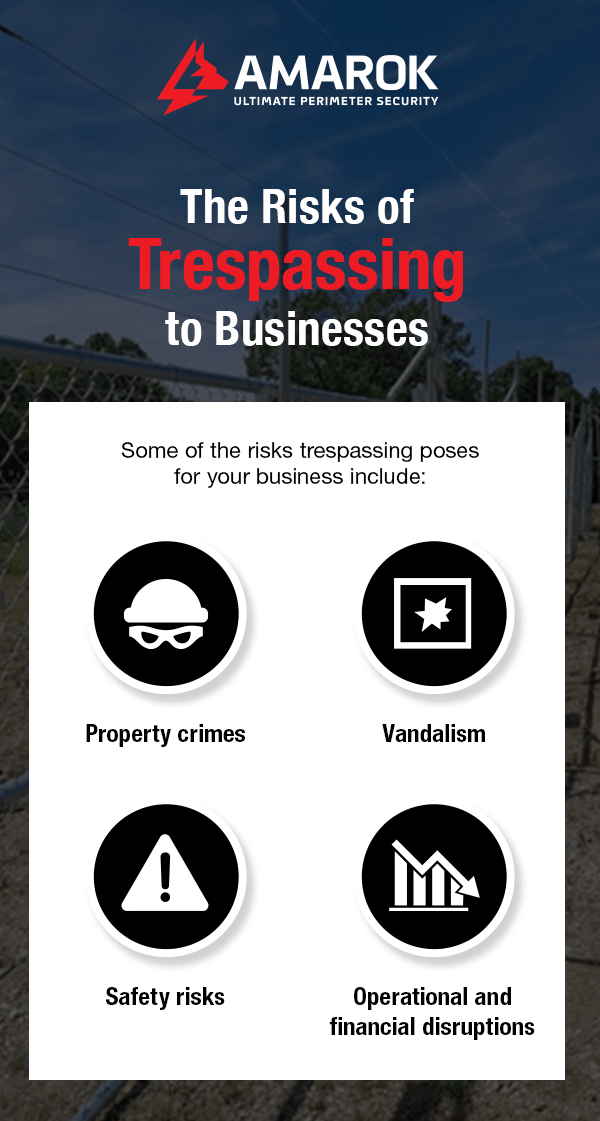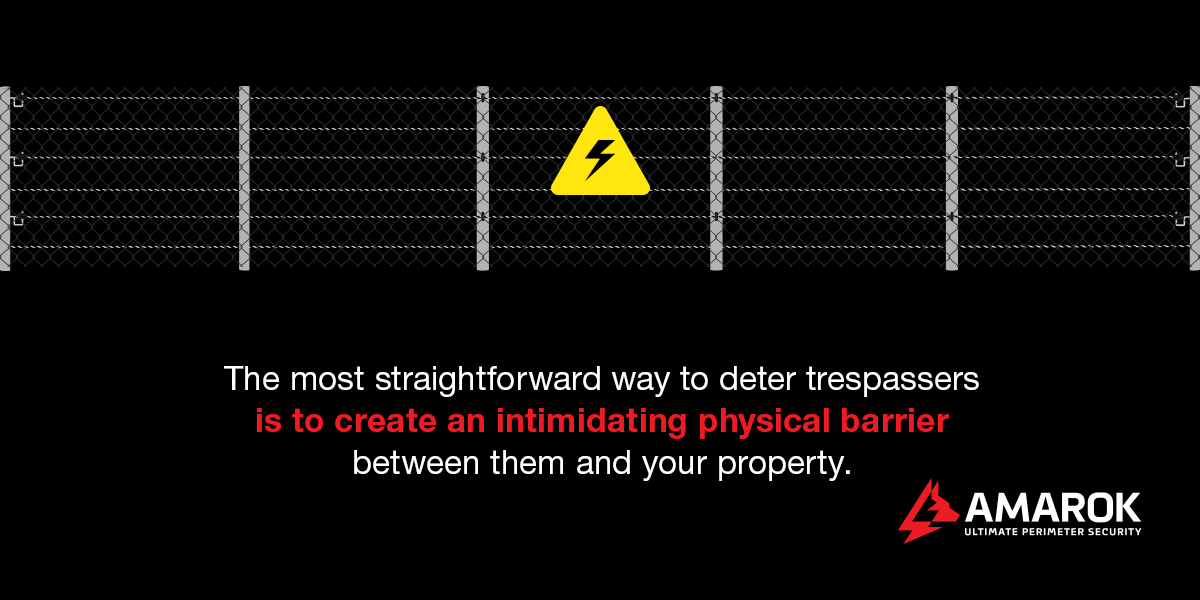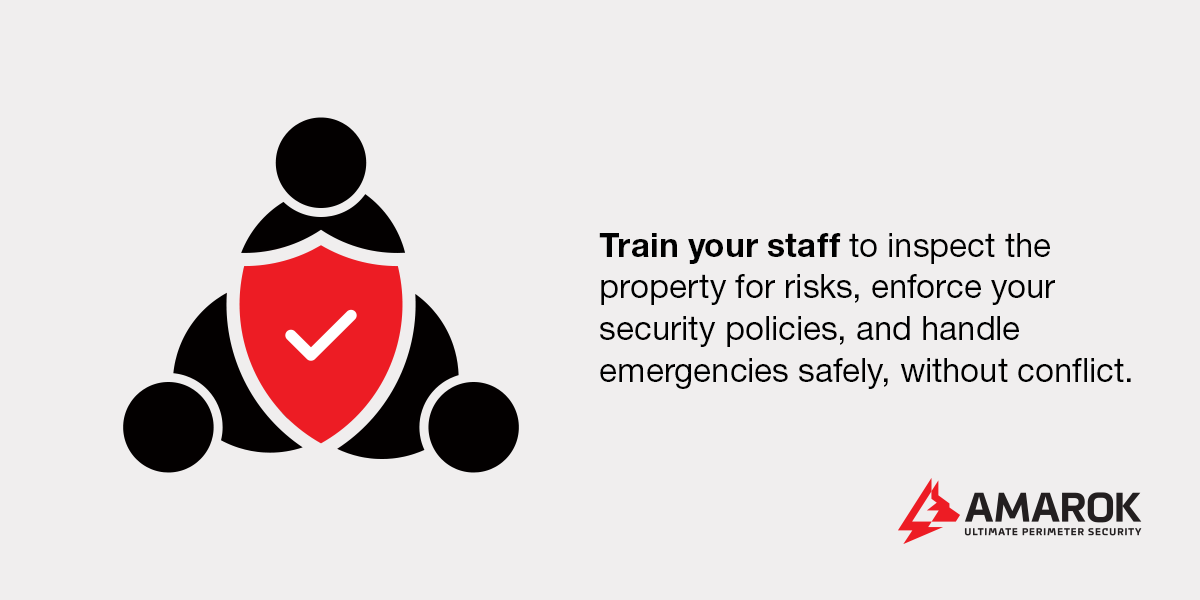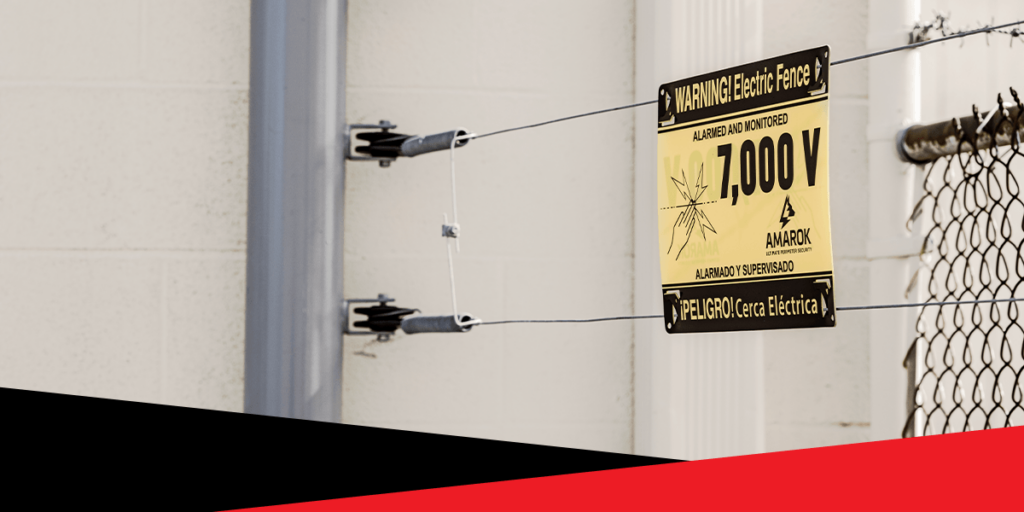A trespasser on a commercial property interferes with the safe operations of that business. Something as simple as loitering in front of a business entrance can hinder operations, making employees and customers feel unsafe. Trespassing can also lead to other crimes, like violence or burglary. Regardless of the outcome, knowing how to stop trespassers in their tracks can only benefit your company.
Criminals are becoming increasingly sophisticated, and it can be challenging to tell the difference between an unwitting trespasser and someone malicious. Preventing trespassing on private property begins with understanding its legal definition. From there, you can follow physical security best practices and make it clear that trespassers are not welcome.
The Risks of Trespassing to Businesses
Before you explore how to stop trespassing on your property and set a budget, it helps to understand the risks. As unauthorized entry often starts as a more passive crime, many businesses underestimate its effects. However, trespassers can easily commit more serious crimes once they are on your property and see the opportunity. In addition, if a trespasser gets injured on your property, they could sue the business and hold you liable. Knowing how to keep people off your property can save your business time and money.

Some of the risks trespassing poses for your business include:
- Property crimes: Trespassers who successfully access your property may commit crimes, including larceny-theft — the most common property crime in the country. Motor vehicle theft and burglary are also common offenses. A trespasser who accesses your property could see an opportunity to commit these crimes and decide to seize it, especially if they can get out undetected.
- Vandalism: Trespassers can do damage without entering your buildings. For instance, they might vandalize external areas, which cost time and money to fix.
- Safety risks: Confronting a trespasser could lead to aggression, posing a threat to your employees. Anyone who enters your property without your permission could have malicious intent, and they could injure a member of staff or sustain an injury themselves.
- Operational and financial disruptions: In addition to the immediate costs of theft or property damage, trespassing can lead to increased insurance premiums, legal fees, and potential lawsuits. It can also disrupt business operations, leading to lost productivity, downtime, and reputational damage.
Steps You Can Take to Prevent Trespassing on Your Commercial Property
Trespassers can have numerous motivations for entering your property, and many of them are criminal. They will look for properties that allow them to gain access unnoticed and exploit vulnerabilities. Learn how to prevent trespassers from accessing your commercial property with the following tips:
1. Understand the Law
Trespassing is a legal term that describes the act of knowingly entering someone’s property without permission. The first step to defending your commercial property is to understand the laws that govern trespassing. These laws evolve constantly to address the changing crime landscape around property rights and privacy. Your rights, and those of the trespasser, vary depending on your location. However, trespassing can be a crime, a civil misdemeanor, or both.
For someone to be considered a trespasser, they must have the intent to get into your property without permission. Similarly, if you ask them to leave and they refuse, many states consider it criminal trespass. Start by knowing how to legally keep someone off your property. If your land is open, you cannot prosecute anyone for being there. The responsibility rests on the property owner to clearly mark and secure the perimeter to prevent accidental or deliberate entry.
2. Conduct a Threat Assessment
Criminals find trespassing easy if a property has obvious weaknesses. An expert threat assessment identifies your current risk of intrusion, vandalism, and property theft. A team of security experts will evaluate your property, taking into account the following factors:
- Size and layout: Your property’s layout, location, and size will determine where you have vulnerable areas with low visibility. Security experts will also assess entry and exit points for weaknesses.
- Current physical security: A threat assessment involves reviewing your existing security posture to uncover improvement opportunities.
- Crime data: These professionals will evaluate local crime and historical data to understand crime patterns and identify vulnerabilities that may apply to your property.
- Business operations: Your operational processes and schedules could reveal opportunities for criminals to gain access to your property. Security professionals will observe these processes and develop a proactive approach to your security by accounting for shifts, peak activity times, closing times, and deliveries.
3. Protect Your Perimeter
The most straightforward way to deter trespassers is to create an intimidating physical barrier between them and your property. Ensure you have a sturdy fence that clearly demarcates your property’s boundary. Then, install an electric security fence inside your perimeter fence. An electric fence is an imposing structure that deters would-be intruders and creates a substantial barrier to unlawful entry.
A visible electric fence is enough to make most criminals think twice about entering. If they do want to test it, they’ll receive a safe but memorable pulsed electric shock — enough to deter even the most determined intruder. In addition, an electric perimeter security fence gives you control over who enters your property, removes weaknesses in your existing perimeter security, and eliminates the need for security guards.

4. Install Visible Signs
Make it clear to would-be intruders that you mean business with signage along your perimeter. You can use these signs to ensure you have a strong case against anyone who attempts to access your property — when there are clear, visible signs everywhere, it’s challenging for criminals to argue that they didn’t know it was off-limits. They also serve as an effective psychological deterrent, stopping crime before it happens. In addition, visible signs warning people about your electric perimeter fence are a legal requirement.
5. Integrate Video Surveillance
Video surveillance is an excellent addition to your perimeter security. Determined intruders will monitor your property and wait for everyone to leave before attempting to gain access. Having measures in place to spot them at the perimeter and inside the property gives you the evidence to act. You can install closed-circuit television (CCTV) cameras throughout your property to get a complete view of vulnerable points.
Remote video monitoring allows you to view live and recorded footage of your property from anywhere with internet access. It forms part of a comprehensive security solution, as properties with these systems are less attractive targets. Having video evidence of trespassing is essential if you want to pursue the issue in court. It also provides evidence to support insurance claims and criminal investigations. Video surveillance is more effective as part of a layered security strategy.
6. Control Unauthorized Access
An access control system incorporates various technologies that allow you to manage who enters your premises. It will enable authorized individuals to enter the space while establishing protocols to prevent entry by unauthorized parties. Your unique requirements dictate which technology you need, but preventing trespassing begins with gate access control.
A system like AMAROK’s Gate Access Control offers protection and security at all of your entrance and exit points. It provides a clear barrier to entry that’s challenging to misinterpret, making it easier to prove intent if someone tries to trespass on your property. Controlling access at the gate with credential readers, intercoms, artificial intelligence (AI) cameras, and specialized gate locks is an important layer in your overall security strategy.
7. Secure the Building
Controlling access to your property is crucial, but you also need to limit access to your commercial building. An intrusion detection system notifies security personnel if someone tries to force a door open and gain access to the facility. Depending on your building’s design, you may be able to incorporate solutions like motion detectors, door contacts, and automated notifications.
Intrusion detection systems limit building access to authorized personnel during and after business hours. This technology works well as part of a layered security strategy that incorporates a robust perimeter fence, video surveillance, and access control.
8. Illuminate the Area
Intruders love working in the dark because it makes it easy for them to get into your property undetected, so they often look for poorly illuminated access points to attempt a breach. Proper lighting can address these areas and eliminate places for criminals to hide. When adding lighting, focus on access points, storage spaces, and any well-concealed regions along your perimeter.
Lighting is a dynamic option for enhancing overall security. You can incorporate lights on a timer in your building to give the illusion that it’s occupied and deter intruders. Alarm-based lighting systems are also an excellent option for your perimeter. If someone activates your electric fence alarm, the system promptly floods the area with light to reveal the intruder.
9. Inspect the Property Regularly
Determined criminals may return to your property more than once to identify any new vulnerable areas. Inspect your property regularly to ensure every element of your security remains effective. When you conduct an inspection, look for the following:
- Security solutions: Ensure that your access control system, video surveillance, and intrusion detection systems are working correctly.
- Lighting: Check that your security lighting is fully functional, and look for any new areas that could conceal criminal activity. You might need additional lighting to secure these areas.
- Vegetation: Maintain the landscaping on your property, especially during summer when foliage is likely to grow. Trim any vegetation along your perimeter and near entrances and windows to eliminate hiding places for trespassers.
- Doors and windows: Ensure that all doors and windows lock properly, check for broken glass, and examine any locks for signs of tampering.
10. Train Your Employees
Well-informed, confident employees can reduce risks and respond effectively during a security incident. Conduct regular training sessions that cover how to act during emergencies, fires, floods, and security events. Ensure they know the laws that govern trespassing and other property crimes so they can act if they see unusual behaviors around your property. Signs of suspicious activity include the following:
- Cars parked in unusual locations
- People loitering near the property
- Vehicles passing by more than once
- Signs of tampering with security equipment
- Suspicious interest in your security
- Graffiti, chalk markings, or tags
Security is a team effort. Train your staff to inspect the property for risks, enforce your security policies, and handle emergencies safely, without conflict. Confrontation is not a trespassing prevention method, and with training, you can keep your employees safe.

11. Know What to Do if Someone Trespasses on Your Property
As a commercial property owner or manager, you have rights and lawful protections related to trespassing incidents. Take the following steps to keep trespassers off your property:
- Determine intent and assess the risks: Evaluate the situation and determine if a trespasser poses an immediate threat to your employees or property. If they do, contact law enforcement immediately and provide them with the video surveillance footage as evidence.
- Contact a reputable law firm: A law firm that specializes in property law can provide guidance on the regulations in your area and advise you on the best course of action. You may be able to bring legal action against the trespasser for an order not to enter the property.
No matter what, avoid engaging in a confrontation with the trespasser, as it could put you or your employees at risk.
12. Adopt a Multi-Layered Security Approach
The best way to deter trespassers is to implement numerous security measures in a strategy known as multi-layered security. As the name suggests, this strategy deploys multiple layers of physical security to protect your commercial property from the outside in. The five D’s of perimeter security are deter, detect, deny, delay, and defend. These layers create multiple barriers between trespassers and your property.
Focus on the following elements to establish a robust security strategy:
- Deter: Deterring trespassers involves making your site intimidating. Make your property challenging to breach with an electric security fence and visible video surveillance equipment. These solutions combined also make it look difficult to leave the site, especially with stolen property.
- Detect: Detecting trespassers involves determining that an incident is in progress as soon as someone attempts to bypass the perimeter, allowing you to alert the authorities. It uses video surveillance, lighting, building intrusion detection, and motion detection to eliminate hiding places and pinpoint an intruder’s location.
- Deny: In this layer, you prevent unauthorized individuals from entering your property using physical measures. It includes fencing, access control, and any other measures that serve to keep trespassers out.
- Delay: Delaying trespassers involves giving the police time to arrive at the scene. Having more than one layer of fencing and additional locks inside your building will slow criminals down if they try to access your valuable assets.
- Defend: This layer involves alerting security personnel or law enforcement officers who can neutralize the threat and take defensive action.
Stop Crime Before It Happens With AMAROK
Trespassing can be the gateway to more serious crime, which costs your business significant time, money, and peace of mind. AMAROK can help you maintain safety and business continuity with our market-leading perimeter security solutions. We deliver robust perimeter protection for any commercial property.
We offer a smart approach to perimeter security with The Electric Guard Dog™ Fence. It delivers a 7,000-volt pulsed shock every 1.3 seconds, making it a safe but memorable deterrent to any would-be intruder. In addition, we believe in a multi-layered security approach that includes options like Gate Access Control and video surveillance to ensure you can keep your property secure. Join more than 8,000 happy customers and talk to an AMAROK security expert. You can also call us at (803) 786-6333 or arrange a free threat assessment.





